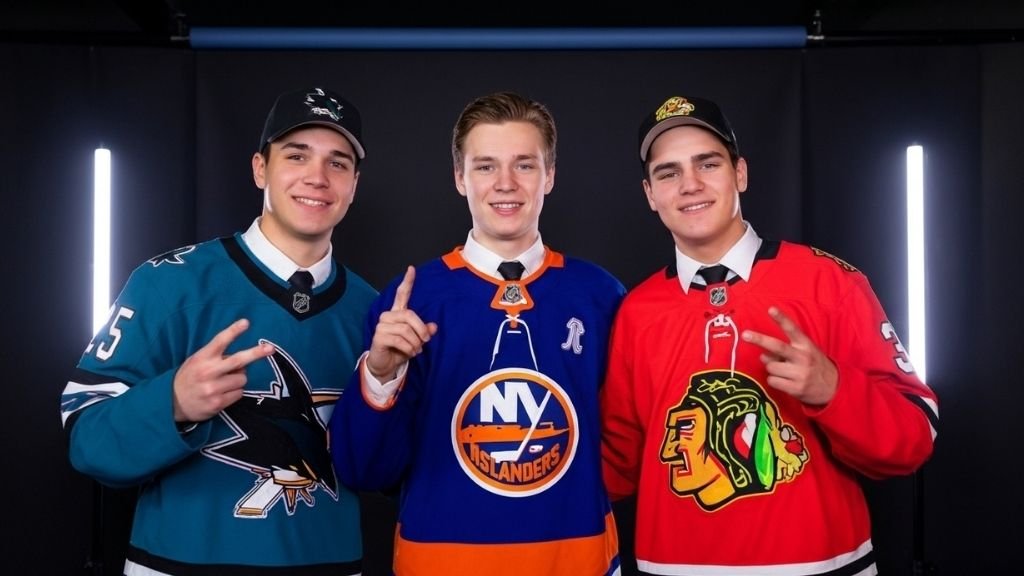There’s a special kind of buzz around training camp when 18-year-old draft picks try to jump straight from junior rinks to the world’s best league. The 2025 class has delivered a handful of real candidates—players who logged meaningful preseason minutes, earned looks in top-nine roles, and forced management to pause before sending them back to junior.
Below is a clean, link-free, original look at the most likely rookies to make it from Day 1 of the regular season—and, crucially, the odds that they last beyond the early-season trial many clubs use before making a decision.
First-overall pressure, first-pair poise: Matthew Schaefer, D, Islanders
Matthew Schaefer has carried the weight that comes with being the top pick and looked comfortable doing it. His preseason showed why he went first overall: efficient exits, a calm first touch under pressure, and a knack for sliding pucks into areas teammates can skate onto. The striking thing isn’t the highlight plays; it’s how few problems he creates for himself. He retrieves, scans early, and moves the puck decisively.
On a veteran-leaning blue line that values structure, Schaefer projects as the rare 18-year-old defender who can avoid becoming a drag on his partner—and might even elevate a steady veteran with his feet and distribution. If you’re picking one 2025 draftee to be on an NHL roster on Opening Night, he’s the safest bet.
The speed merchant’s balancing act: Michael Misa, C, Sharks
Michael Misa’s camp hasn’t been as relentlessly tidy as Schaefer’s, but his peaks have been undeniable: deceptive entries, lateral threats off the rush, and that ability to sell shot before slicing a pass through the seam. San Jose’s forward group is young and still building, which can cut both ways. On one hand, there are minutes available next to other first-round talents; on the other, learning NHL defensive routes while anchoring a line against grown pros is a mountain to climb.
Misa’s feet and hands say he can help on the power play right now. The question is how quickly he adapts to NHL contact and tempo at five-on-five. If the Sharks decide a rapid learning curve alongside their young core outweighs the risk of occasional defensive chaos, Misa could be kept past the initial trial. You can also see a path where he gets a taste, flashes skill, and returns to junior to dominate before coming back for good.
The power forward who looks ready now: Brady Martin, LW, Predators
Fifth-overall pick Brady Martin has blended in seamlessly with Nashville’s forward identity: heavy, direct, and purposeful. Late in camp he even earned looks alongside veteran play-drivers—a tell that the staff wanted to see how his game translated with top-six thinkers. Martin uses his frame to win body position early in sequences, which lets him receive pucks on his forehand rather than chasing them.
There’s still polishing to do on his defensive recognition, but his north-south game, puck protection on the walls, and willingness to drive the crease scream “NHL-ready depth” right away. Preseason counting stats matter less than process, yet it hasn’t hurt that Martin chipped in points. Considering Nashville’s appetite for forwards who can win below the dots and extend cycles, Martin has one of the sturdier cases to stick.
Vancouver’s thorny roster call: Braeden Cootes, C, Canucks
Vancouver has been searching for reliable, play-driving depth behind its stars, and Braeden Cootes has made the decision at least uncomfortable. He doesn’t just chase pace—he creates it by getting off the wall quickly and attacking the slot without extra dust. The most impressive part of his preseason: he doesn’t need the puck to be effective. His timing into soft ice looks pro-level, and he’s strong enough on his edges to win loose pucks against older defenders.
The flip side is obvious: asking an 18-year-old to handle tough matchups can backfire, and the Canucks have veteran options they can trust situationally. If they keep Cootes, expect them to insulate him with a veteran winger and start his NHL life with protected usage and second-unit special-teams work.
A high-ceiling swing in Buffalo: Radim Mrtka, D, Sabres
Radim Mrtka has flashed the tools—mobile feet, quick hands at the blue line, a mind that thinks “north” by default—that fit Buffalo’s downhill identity. The staff can already envision him as a puck-moving second-pair driver down the road. The question is timing. When Mrtka’s off the puck, you still catch some junior habits: following play rather than anticipating it, trusting his stick more than his shoulders in battles, drifting a half-step outside the layers you need to stay inside at this level.
Those are normal 18-year-old defenseman issues, and there’s no shame in sending him back to convert flashes into habits. With a clean bill of health across the Sabres’ blue line, the median outcome might be a short cameo followed by a return to junior, which could set him up to arrive next fall ready to grab a permanent role.
The small winger forcing big decisions: Benjamin Kindel, RW, Penguins
Benjamin Kindel has been as advertised: small surface area, big-engine game. He plays quickly without rushing, taking smart arcs to arrive with speed and support skilled linemates. The boxcar numbers haven’t exploded, but the tape shows repeatable NHL traits—pace, retrievals won by route rather than raw mass, and well-timed bumps to the slot.
On a veteran roster with contenders’ ambitions, that may still not be enough. Pittsburgh can reasonably decide that another winter of top-line junior minutes—first unit, every situation, puck on his stick a lot—does more to raise his ceiling than sporadic NHL shifts on a fourth line. If injuries pile up or lineup shuffles create a vacancy for speed, though, Kindel could be an easy plug-in.
How the nine-game runway shapes decisions
For many CHL-eligible skaters, teams can use the familiar “slide” window: up to nine NHL games without burning the first year of the entry-level contract. It’s a crucial tool for front offices, letting them test whether a teenager is over-matched or merely green without paying a cap and contract price. Clubs often script those nine games strategically—heavy on home dates for matchups, lighter on back-to-backs, mindful of travel—to isolate what the player can control and measure real NHL habits. If you’re tracking the 2025 class, watch how coaches deploy them within that window; usage will tell you how close the staff thinks they are.
The case for sticking: immediate value versus long-term upside
There are two thresholds an 18-year-old must clear to survive past the slide:
Can he help you win an NHL game right now?
That doesn’t necessarily mean scoring; it might mean clean exits, allowing a coach to shorten the bench less often, or adding second-unit power-play threats that force penalty kills to defend differently. Schaefer’s calm puck management checks that box. Martin’s interior game could, too. Cootes’ knack for arriving in the slot on time does the same for Vancouver. If a rookie reliably tilts shifts toward the right end of the rink—even modestly—coaches find ways to live with the mistakes.
Will keeping him in the NHL develop his ceiling more than sending him back?
This is where Misa and Kindel sit on the fence. Misa’s rush game will be tested by NHL gaps and pressure; staying might accelerate that learning. But if he’s chasing his touches five-on-five, he might grow more efficiently back in junior where he can play 20 minutes every night and own the puck. Kindel faces a similar calculus in Pittsburgh: there’s clear NHL utility, but there’s also the lure of a starring role in junior that could sharpen his finishing touch.
Depth charts, waivers, and the numbers game
Talent isn’t the only factor. Cap space, waiver status, and injuries often tip these decisions. Veterans on one-way deals who require waivers to be sent down are harder to move out of the way. Conversely, early-season injuries can create short-term openings that align perfectly with the nine-game runway. If you see a club place a depth winger on waivers or a middle-pair defender hit injured reserve, that often opens a lane for one of these teens to get real NHL looks immediately. The final week of camp is always a roster traffic jam; the kids who survive it typically did two things: they helped on special teams and didn’t leak scoring chances at five-on-five.
Team-by-team outlooks for the six headline draftees
Islanders (Schaefer): The most straightforward projection. The Islanders have insulated young defensemen before by pairing them with stay-at-home partners and using heavy structure to simplify reads. Schaefer’s smooth retrievals and quick first passes reduce the strain on his pair. Expect second-pair minutes at even strength, second-unit special teams, and coaching guardrails that emphasize short shifts and clean decisions.
Sharks (Misa): San Jose is building around a young skill core. If the staff chooses to keep Misa, it likely comes with power-play time and a protected five-on-five role next to a play-driving center. The first back-to-back and the first heavy road swing will be telling; if his touches vanish and the tracking shows too many one-and-done entries, the club will probably opt for the junior return before game ten. But if his pace holds and he draws penalties with that east-west threat, he can buy himself real calendar runway.
Predators (Martin): Nashville loves forwards who extend possession and arrive at the net front with timing. Martin’s game fits the brand, and those camp looks next to high-IQ veterans suggest the club believes his details can hold. If he sticks, expect quick rotations between line two and line three while the staff tests chemistry and zone-start mixes.
Canucks (Cootes): Vancouver’s best version of itself features a third line that flips the ice and chips in goals. Cootes’ value is that he finds dangerous ice without needing perfect puck service. If he earns early results, the Canucks can keep him even if they manage his matchups carefully. If the offense dries up and the cap-and-waiver math gets messy, they may still send him back with a promise and a plan.
Sabres (Mrtka): This is the trickiest call. Buffalo is committed to playing fast, and Mrtka amplifies that when the puck is on his stick. But NHL defending without the puck is the tax you pay to use that offense, and teenagers rarely get a free pass on details. A short NHL cameo followed by a return to junior feels like the median outcome—valuable for both player and club.
Penguins (Kindel): Pittsburgh’s decision matrix is harsher because of where the team sits in its competitive cycle. If veterans are healthy, the club may prefer predictable two-way minutes from experienced depth. If injuries linger or lineup shuffles create a vacancy for speed, Kindel could grab it. Either way, the organization has to like how quickly he adapted to pro pace in camp.
The nine-game test: what to watch next
If you’re tracking which rookies will last past October, focus on four things during the slide window:
Usage: Are they trusted for defensive-zone starts after an icing, or are shifts carefully curated? Coaches show their hand with matchups.
Special teams: Power-play time is a vote of confidence; penalty-kill reps are an outright trust fall.
Recovery shifts: Every teenager will get beat. What happens next—how quickly he resets, how effectively he supports his partner—matters.
Travel and back-to-backs: Team staff often plan slide games to test fatigue management. If a teenager looks the same on a three-in-four as he does at home after two days off, that’s a green flag.
Clubs don’t need these kids to be stars in October. They need them to be net positives or, at worst, neutral players who don’t bleed chances against. If the curve is clearly going up within those first nine games, the decision to keep them becomes easier.
A note on expectations and patience
History tells us that even the brightest teens rarely dominate immediately. Defensemen in particular face an unforgiving learning curve: reads get faster, gaps get tighter, and small mistakes end up behind your goaltender. That’s what makes Schaefer’s calmness so compelling—he already plays the pro game at pro speed without hunting the big play every shift. For forwards, you often see the opposite pattern: bursts of offense before the defensive structure catches up. Misa, Martin, and Cootes have all shown NHL-transferable skills, but how they handle neutral-zone tracking, back pressure, and weak-side responsibilities will determine whether they’re December regulars or October cameos.
So who actually makes it?
If you force a ranking based on camp form, usage hints, and roster context, Schaefer sits at the top with the clearest path to a full-season role. Martin looks like a credible opening-night forward with a stylistic fit coaches adore. Cootes has the brain and strength to fill a depth need, though Vancouver’s cap and waiver puzzle could still push him back to junior even if he passes the eye test.
Misa’s ceiling is the highest among the forwards, but the risk-reward calculus may nudge San Jose toward a short audition rather than a full-season investment. Mrtka, given the defending details, feels like a near-miss who benefits from another winter of heavy minutes. Kindel can absolutely be a short-term solution for Pittsburgh if the depth chart opens—even if the long-term plan remains “dominate in junior, then come back to win a job.”
The bigger picture for the 2025 class
Step back, and the larger story is how mature this draft cohort already looks. There’s a real chance that multiple 2025 first-rounders are still in the NHL after the slide—rarer than fans might think. What stands out is the variety of profiles: a poised, play-driving defenseman; a rush-driven creator; a power winger who can live at the interior; a crafty center who reads space; a mobile puck-mover with bite; and a smaller winger whose speed solves problems. It’s a rich mix for a league that keeps getting quicker and smarter. If even half of these players survive past the nine-game mark, the 2025 class will start building its reputation in a hurry.







